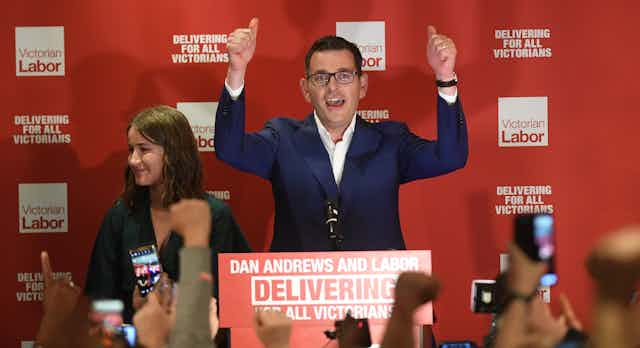On election night, the ABC had Labor winning 58 of the 88 seats, to 20 for the Coalition. After late counting of pre-poll and postal votes, the ABC now shows Labor has won 52 of the 88 lower house seats, the Coalition 24, two Independents and ten seats are undecided, with 71% of enrolled voters counted.
Read more: Labor has landslide win in Victoria
Statewide primary votes are currently 42.9% Labor (up 4.8% since the 2014 election), 35.8% Coalition (down 6.3%) and 9.8% Greens (down 1.6%). As much of the Coalition-favouring pre-polls and postals have been counted, I expect the Greens to gain in late counting as left-leaning polling-day absent votes are counted.
In two party Labor vs Coalition terms, The Poll Bludger has Labor winning by 56.0-44.0 in seats that currently have such a count – that is, excluding Labor vs Greens counts in inner city seats, and Coalition vs independents in the regions. In seats with a two party count, the swing to Labor is 5.3%, which would be a 57.3-42.7 thrashing if projected to the whole state.
The Liberals have lost eastern suburbs heartland seats such as Mount Waverley, Burwood, Ringwood and Box Hill to Labor, but they have retained Caulfield and likely Sandringham, which looked likely to be losses earlier in the night. In Hawthorn, the Liberals lead by 53 votes, with many absent votes to come.
While the ABC currently lists Melbourne as in doubt, Greens-favouring absent votes will easily win it for the Greens. Labor leads the Greens by 72 votes in Brunswick, and will probably lose on absent votes. Labor has clearly retained Richmond against the Greens, and will regain Northcote, which they lost at a byelection. In Prahran, whichever of Labor or Greens finishes second will defeat the Liberals on the other’s preferences.
An independent has gained Mildura from the Nationals, and an independent has retained Shepparton. According to analyst Kevin Bonham, independents are some chance in Geelong, Benambra, South-West Coast, Morwell, Melton and Pascoe Vale; in some of these seats, independents are currently third, but could move ahead of a major party, then receive that major party’s preferences. These seats do not yet have a two candidate count against the independent; the ABC is guessing the two candidate result.
Micro parties could win ten upper house seats
The ABC’s upper house calculator currently has Labor winning 19 of the 40 upper house seats, the Coalition ten, the Greens one, and ten from other parties. These others include four Derryn Hinch Justice, two Transport Matters, one Aussie Battler, one Animal Justice, one Liberal Democrat and one Sustainable Australia.
Read more: Poll wrap: Labor's worst polls since Turnbull; chaos likely in Victorian upper house
Overall upper house vote shares were 40.8% Labor, 28.2% Coalition, 9.2% Greens, 3.4% Hinch Justice and 0.6% Transport Matters. It is ludicrous that a party with 0.6% of the vote could win one more seat than a party with 9.2%, or that a party with 3.4% could win three more seats than the Greens.
The upper house count is only at 42.5%, while the lower house is at 71.1%. The pre-poll and postal votes that have assisted the Coalition in the lower house have not yet been tallied for the upper house. When they are counted, Labor will drop back and the Coalition will gain.
The below-the-line vote rate increased to about 10% at this election, from 6% in 2014. As the ABC calculator assumes that all upper house house votes are above-the-line ticket votes, errors can occur if the calculator margin at a critical point is close. Bonham thinks the Coalition will do a bit better at the expense of micro parties, but he still thinks there will be at least six micro party members.
If Labor wins 19 upper house seats, they will be in a strong position in the upper house. Since the election was a Labor landslide, they performed well in the upper house. Had Labor done worse, there would have been some incentive for them to attempt to reform group voting tickets, but this is now unlikely to happen.

